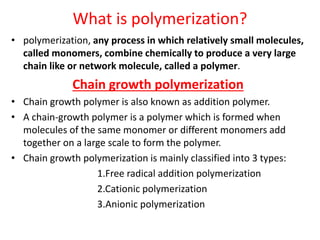
UNIT-2 POLYMER.pptx
- 1. What is polymerization? • polymerization, any process in which relatively small molecules, called monomers, combine chemically to produce a very large chain like or network molecule, called a polymer. Chain growth polymerization • Chain growth polymer is also known as addition polymer. • A chain-growth polymer is a polymer which is formed when molecules of the same monomer or different monomers add together on a large scale to form the polymer. • Chain growth polymerization is mainly classified into 3 types: 1.Free radical addition polymerization 2.Cationic polymerization 3.Anionic polymerization
- 2. 1.Free radical addition polymerization • Free-radical polymerizations are chain reactions in which the addition of a monomer molecule to an active chain-end regenerates the active site at the chain-end. • Free-radical polymerizations is always done in presence of heat or sunlight. • Free Radical Polymerization occurs in three steps, i.e. (1) Initiation (2) Propagation (3)Termination. (1) Initiation • Initiation is the first step in the polymerization process. • An active centre is generated in this process to begin polymerization. • All the monomers are not liable for the initiation process. • One or two radicals are created from the initiating molecules in the first step. • Radicals are transferred from the initiating molecules to the monomer units in the second step.
- 3. • NOTE: If we want to start initiating step for polymerization then we need any peroxide group (benzoyl peroxide, Acetyle peroxide, di-oxide etc) that creates free radical for chain growth.
- 5. (2) Propagation • A polymer spends most of its time expanding its chain length or propagating. After initiation of free radical, it attacks another monomer subunit. • After initiation, the chain propagates until no monomer is left or termination starts.
- 6. (3)Termination • Termination is the final step in the polymerization process.
- 7. Applications of Free Radical Polymerization • It is used in synthesizing polystyrene and elastomers. • It is used in synthesizing chemical surfactants, lubricants.
- 8. Some Common Addition Polymers
- 9. 2.Cationic polymerization • Cationic polymerization is a type of chain growth polymerization in which a cationic initiator transfers charge to a monomer which then becomes reactive.(it initiated by Acid) • For cationic polymerization, requires Strong Acids like H₂SO₄/Lewis acids(AlCl₃). • Suppose we take H₂SO₄ and in solution it gives H+ + HSO4 – ions. (H₂SO₄ ------ > H+ + HSO4 – ) (As we know that H+ Requires electrons so take ethylene as example.)
- 10. Example of Cationic polymerization Polystyrene, poly isobutylene. 3.Anionic polymerization • Cationic polymerization is a type of chain growth polymerization in which an anionic initiator transfers charge to a monomer which then becomes reactive.(it initiated by Base) • For anionic polymerization,requires Strong Base like NaNH2(sodamite)/ R−Mg−X (Grignard reagent)